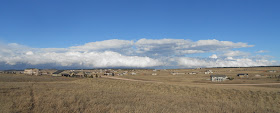The storm that hit Denver today making it's way in.
The local papers and newscasts have been harping about the snowpack being only 60% to 70% of normal for the year (10% variance depending on the source) lately. In typical oh-my-god-we're-all-going-to-die alarmist journalistic fashion, the talking heads and pundits have mapped out doomsday scenarios wherein reservoirs dry up, crops fail, and the world as we know it comes to a screeching halt.
Is there some special school that story editors who work in news media attend where they learn worst case scenario reporting tricks and techniques? Distorting Data 101? Manipulating Historical Context To Exaggerate Weather Extremes (with required Lab)? Advanced Misstatement Of Scientific Research?
In the time I've lived in Colorado, the snowpack has fluctuated dramatically from year to year. My first visit to Denver, courtesy of the USAF, was in 1981 (It was also the first time I ever experienced snow). 1981 was a below average year for snow, but it was the most snow I'd ever seen, so I thought it was a lot. The very next year, 1982, one of the heaviest snowfalls in Denver history was recorded. That was really a lot of snow.
This winter has been fairly average in my recent experience, which covers the past 15 years of winter in Colorado. Everyday I hear a friend or co-worker comment that this winter is much dryer than any other, but they can't be basing their statements on facts, just a memory of extremes such as the nearly 3 feet that fell in March of 2003.
Because the facts are the facts. NOAA's National Climatic Data Center reports that the Denver area only averages 16 days a year of snowfall that exceeds 1 inch. That's based on three decades of averages, BTW. That's really not a lot of snowfall, and fairly easy to dismiss as insignificant, especially since it usually melts before it can accumulate.
Of course I may be a bit biased about what constitutes a lot of snowfall having lived through 9 winters in Anchorage, where the snow doesn't melt until April or May.
Yesterday's paper stated that this January's snowfall along the front range will be close to normal, which is 7 inches.
The paper also quoted a couple of weather people making dire predictions about the consequences of no significant snowfall in the foreseeable future.
Then the storm came. Today, one day after the doomsday statements were printed. The paper reported that this storm is expected to bring anywhere from 1 to 2 inches of snow along the front range, but in the mountains the all-important snowpack will increase by 8 to 16 inches, and in southwestern Colorado possibly up to two feet.
The actual snowfall for 1-28-2013 in my backyard smack dab in the middle of the front range, just a tad over 4 inches (advanced precision measurement device used is similiar to the ones the National Weather Service employs)
I should have been a weatherman - I'm wrong all the time and I never get paid for it.


No comments:
Post a Comment